Cite this document
(“Health promotion Essay Example | Topics and Well Written Essays - 2000 words”, n.d.)
Health promotion Essay Example | Topics and Well Written Essays - 2000 words. Retrieved from https://studentshare.org/health-sciences-medicine/1489007-health-promotion
Health promotion Essay Example | Topics and Well Written Essays - 2000 words. Retrieved from https://studentshare.org/health-sciences-medicine/1489007-health-promotion
(Health Promotion Essay Example | Topics and Well Written Essays - 2000 Words)
Health Promotion Essay Example | Topics and Well Written Essays - 2000 Words. https://studentshare.org/health-sciences-medicine/1489007-health-promotion.
Health Promotion Essay Example | Topics and Well Written Essays - 2000 Words. https://studentshare.org/health-sciences-medicine/1489007-health-promotion.
“Health Promotion Essay Example | Topics and Well Written Essays - 2000 Words”, n.d. https://studentshare.org/health-sciences-medicine/1489007-health-promotion.


